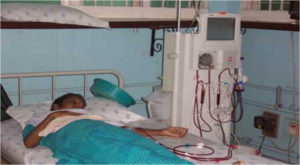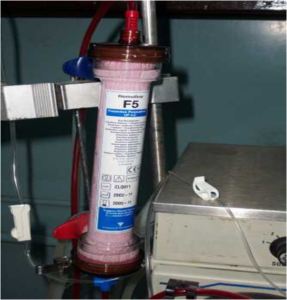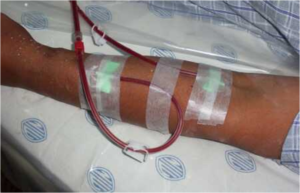The first artificial kidney machine was developed in 1943 by Dr.Willem Kolff. Hemodialysis is derived from two words, hemo, meaning blood and dialysis. Today, it has become the most commonly performed type of dialysis. Hemodialysis treatments are required two to three days per week, and each treatment lasts about four hours.

Figure: A patient undergoing Hemodialysis.
How it works?
During hemodialysis treatment, the patients blood is circulated outside of the body into an machine, through a link to the patients circulatory system. The blood circulates through a dialyser and returns to the patient. A chemical solution called dialysate circulates in the opossite direction through the dialyser. ,The dialysis process is continual, with new blood and dialysate constantly circulating into the machine and waste products and excess fluids constantly circulating out.
 t
t
Figure: A picture of Dialyser
The artificial kidney machine contains an internal chamber which is divided by a thin semipermeable membrane. It is called semipermeable because only particles of a certain size will pass through it. On one side of the membrane is a special solution called dialysate. On the other side is the blood which needs to be cleansed. Since red and white blood cells are relatively large, they will not pass through the pores of the membrane, but waste products (such as creatinine and urea) are very tiny and will pass through the membrane.
Waste products are removed from the blood through three chemical processes: Diffusion, Osmosis and Ultrafiltration.
- Ultra-filtration is the process by which very minute particles are removed from a substance, in this case the blood. In order to speed up the removal of excess fluid, a pump may be used. This pump raises the pressure of the blood flowing through the dialysis machine, thereby forcing excess fluids out of the blood.

Figure: Hemodialysis access site. AV Fistula
Access for Hemodialysis:
In order to be dialyzed there must be a way to connect your circulatory system to the artificial kidney machine. This connection is called a vascular access and initially requires minor surgery. The fistula is created by a surgical procedure which attaches a vein to an artery in an arm. This increases the amount of blood that flows through the vein which in turn causes the vein to enlarge. The larger size of the blood vessel allows two needles to be inserted for treatment.
These needles are connected to tubes which go to and from the artificial kidney machine. A graft also provides access to the patients circulatory system. When a graft is used, synthetic material is inserted to form a connection between an artery and a vein. The advantage of the graft and fistula, which both require minor surgery, is that they are under the skin and therefore less prone to infection than an external shunt. They do require two needle sticks each time dialysis is performed. Sometimes a person must start dialysis before a permanent access can be created. In this case, a catheter may be inserted into a vein in your chest, neck or leg to gain access to the circulatory system. A catheter may also be used if the patient has used up all other possible sites for a fistula or graft. The advantage of a catheter is that no needles need to be inserted. The disadvantages are numerous, including the possibility of infection and clotting.